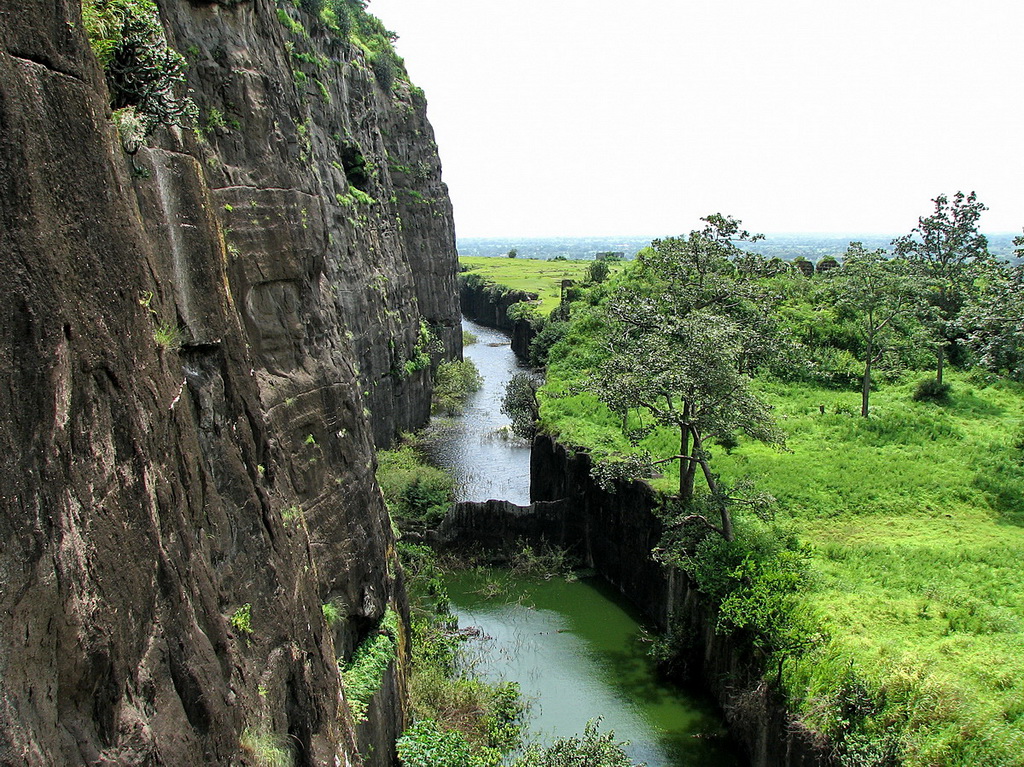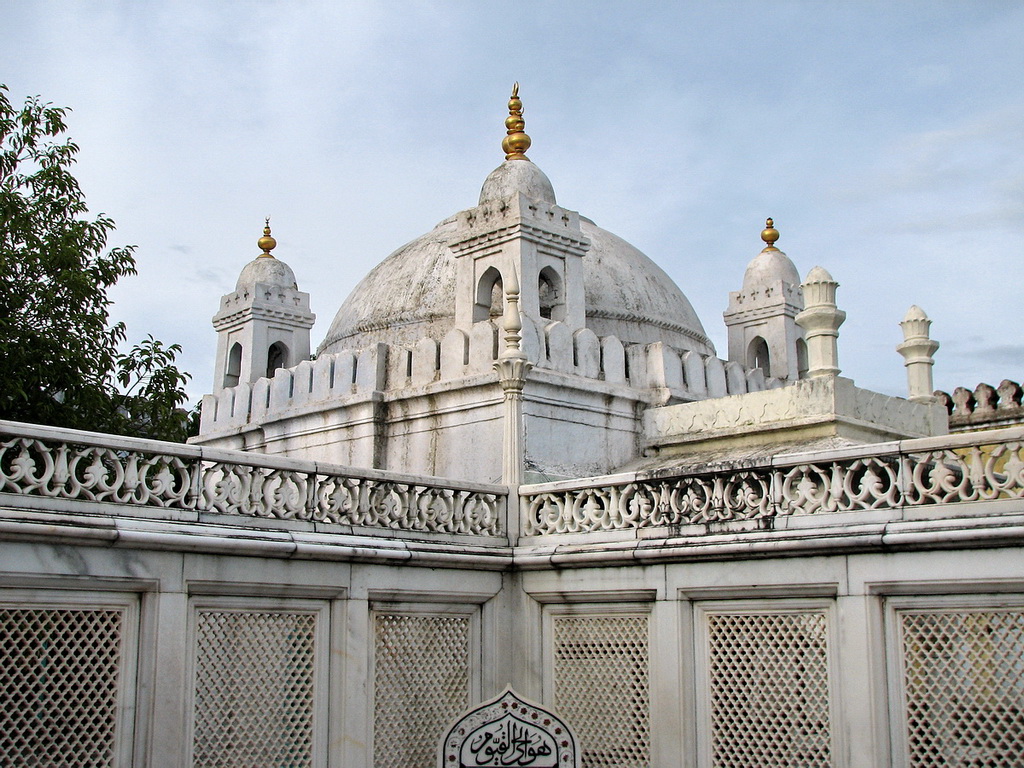|
Khultabad
Khuldabad () is a city (municipal council) and a Taluka of Aurangabad district in the Indian state of Maharashtra. It is known as the Valley of Saints, or the Abode of Eternity, because in the 14th century, several Sufi saints chose to reside here. The Bhadra Maruti Temple and Dargah of Zar Zari Zar Baksh, Shaikh Burhan ud-din Gharib Chisti and Shaikh Zain-ud-din Shirazi, along with the tomb of the Mughal emperor Aurangzeb and his trusted General Asif Jah I, the first Nizam of Hyderabad, are located in this town. It is a holy and spiritual city of Islamic saints. The place has famous Bhadra Maruti Temple. People come from Aurangabad and nearby places by walk for offering puja on Hanuman Jayanti and on Saturdays in Marathi calendar month "Shravan". Nearby is the Valley of the Saints, which is purported to contain the graves of 1500 Sufi saints. Etymology The name 'Khuldabad' translates to 'Abode of Eternity'. It is derived from the post-humous title of Mughal Emperor ... [...More Info...] [...Related Items...] OR: [Wikipedia] [Google] [Baidu] |
Daulatabad Fort
Daulatabad Fort, also known as Devagiri Fort or Deogiri Fort, is a historic fortified citadel located in Daulatabad village near Aurangabad, Maharashtra, India. It was the capital of the Yadava dynasty (9th century–14th century CE), for a brief time the capital of the Delhi Sultanate (1327–1334), and later a secondary capital of the Ahmadnagar Sultanate (1499–1636). Around the 6th century CE, Devagiri emerged as an important uplands town near present-day Aurangabad, along caravan routes going towards western and southern India. The historical triangular fortress in the city was initially built around 1187 by the first Yadava king, Bhillama V. In 1308, the city was annexed by Sultan Alauddin Khalji of the Delhi Sultanate, which ruled over most of the Indian subcontinent. In 1327, Sultan Muhammad bin Tughluq of the Delhi Sultanate renamed the city from Devagiri to Daulatabad and shifted his imperial capital to the city from Delhi, ordering a mass migration of Delhi's popula ... [...More Info...] [...Related Items...] OR: [Wikipedia] [Google] [Baidu] |
Bhadra Maruti Temple, Khuldabad
Bhadra Maruti Temple, Khultabad is a temple dedicated to the Hindu deity Hanuman, located at Khuldabad, near Chhtrapati Sambhaji Nagar, Maharashtra. The temple is located four kilometers from the Ellora Caves. At this temple, the idol of Hanuman is portrayed in a reclining or sleeping posture. It is one of only three places where Hanuman is represented in a sleeping posture. The second noted place is a temple on the banks of at sangam in and Uttar Pradesh and the third is at |
States And Territories Of India
India is a federal union comprising 28 states and 8 union territories, with a total of 36 entities. The states and union territories are further subdivided into districts and smaller administrative divisions. History Pre-independence The Indian subcontinent has been ruled by many different ethnic groups throughout its history, each instituting their own policies of administrative division in the region. The British Raj mostly retained the administrative structure of the preceding Mughal Empire. India was divided into provinces (also called Presidencies), directly governed by the British, and princely states, which were nominally controlled by a local prince or raja loyal to the British Empire, which held ''de facto'' sovereignty ( suzerainty) over the princely states. 1947–1950 Between 1947 and 1950 the territories of the princely states were politically integrated into the Indian union. Most were merged into existing provinces; others were organised into ... [...More Info...] [...Related Items...] OR: [Wikipedia] [Google] [Baidu] |
Khwaja Zainuddin Shirazi
Hazrat Khawaja Syed Shah Maqdoom Zain-ud-din Dawood bin Hussain Shirazi is a Sufi saint of the Deccan, belonging to the Chishti Order . Syed Zainuddin's life Syed Zain ud din Daud (* Hijri 701/1302 CE, † Hijri 771/1370 CE) was born at Shiraz and went to Delhi by way of Mecca. He studied under Maulana Kamaluddin of Samana, and came with him to Daulatabad. The author of the "Mayrat-al Walayeh" mentions that Zainuddin, on his arrival at Daulatabad, disapproved of the singing and dancing in the convent of Burhan uddin; but when he visited the " tekkieh", he was perfectly satisfied, and he and his companions were initiated in the Chishtia order. Syed Zainuddin held the office of "kazi" at Daulatabad, and in H. 737 (1336 CE) was invested with the mantle of the kaliphat, but did not actually succeed till after Burhan ud din's death in H. 741 (1340 CE). Syed Husain has recorded all the sayings of Zainuddin in his "Hidayat ul Kalul", and mentions that in H. 747 (1346 CE), sultan Muh ... [...More Info...] [...Related Items...] OR: [Wikipedia] [Google] [Baidu] |
Sufis
Sufism ( ar, ''aṣ-ṣūfiyya''), also known as Tasawwuf ( ''at-taṣawwuf''), is a mysticism, mystic body of religious practice, found mainly within Sunni Islam but also within Shia Islam, which is characterized by a focus on Islamic spirituality, ritualism, Asceticism#Islam, asceticism and esotericism. It has been variously defined as "Islamic mysticism",Martin Lings, ''What is Sufism?'' (Lahore: Suhail Academy, 2005; first imp. 1983, second imp. 1999), p.15 "the mystical expression of Islamic faith", "the inward dimension of Islam", "the phenomenon of mysticism within Islam", the "main manifestation and the most important and central crystallization" of mystical practice in Islam, and "the interiorization and intensification of Islamic faith and practice". Practitioners of Sufism are referred to as "Sufis" (from , ), and historically typically belonged to "orders" known as (pl. ) – congregations formed around a grand who would be the last in a Silsilah, chain of succe ... [...More Info...] [...Related Items...] OR: [Wikipedia] [Google] [Baidu] |
Delhi
Delhi, officially the National Capital Territory (NCT) of Delhi, is a city and a union territory of India containing New Delhi, the capital of India. Straddling the Yamuna river, primarily its western or right bank, Delhi shares borders with the state of Uttar Pradesh in the east and with the state of Haryana in the remaining directions. The NCT covers an area of . According to the 2011 census, Delhi's city proper population was over 11 million, while the NCT's population was about 16.8 million. Delhi's urban agglomeration, which includes the satellite cities of Ghaziabad, Faridabad, Gurgaon and Noida in an area known as the National Capital Region (NCR), has an estimated population of over 28 million, making it the largest metropolitan area in India and the second-largest in the world (after Tokyo). The topography of the medieval fort Purana Qila on the banks of the river Yamuna matches the literary description of the citadel Indraprastha in the Sanskrit ... [...More Info...] [...Related Items...] OR: [Wikipedia] [Google] [Baidu] |
Delhi Sultanate
The Delhi Sultanate was an Islamic empire based in Delhi that stretched over large parts of the Indian subcontinent for 320 years (1206–1526).Delhi Sultanate Encyclopædia Britannica Following the invasion of by the , five dynasties ruled over the Delhi Sultanate sequentially: the Mamluk dynasty (1206–1290), the Khalji dynasty (1290–1320), the |
Muhammad Bin Tughluq
Muhammad bin Tughluq (1290 – 20 March 1351) was the eighteenth Sultan of Delhi. He reigned from February 1325 until his death in 1351. The sultan was the eldest son of Ghiyath al-Din Tughluq, founder of the Tughlaq dynasty. In 1321, the young Muhammad was sent by his father to the Deccan Plateau to fight a military campaign against the Kakatiya dynasty. In 1323, the future sultan successfully laid siege upon the Kakatiya capital in Warangal. This victory over King Prataparudra ended the Kakatiya dynasty. Muhammad ascended to the Delhi throne upon his father's death in 1325. Accounts by visitors of the Sultan Muhammad n describe him as an "inhuman eccentric" with bizarre character. The sultan is said to have ordered the massacre of all the inhabitants of the Hindu city of Kannauj. He is also known for his wild policy swings. Muhammad bin Tughluq had an interest in medicine. He was also skilled in several languages: Persian, Hindavi, Arabic, Sanskrit and Turkish. Ibn Batt ... [...More Info...] [...Related Items...] OR: [Wikipedia] [Google] [Baidu] |
Rauza
Rauza, Rouza, Roza ( ur, , bn, রৌজা, hi, रौज़ा) is a Perso-Arabic term used in Middle East and Indian subcontinent which means shrine or tomb. It is also known as mazār, ''maqbara'' or ''dargah''. The word ''rauza'' is derived through Persian from the Arabic ''rawdah'' ( ''rawḍah'') meaning garden, but extended to tomb surrounded by garden as at Agra and Aurangabad. Abdul Hamid Lahauri, the author of the Badshahnama, the official history of Shah Jahan's reign, calls Taj Mahal ''rauza-i munawwara'' (Perso-Arabic The Persian alphabet ( fa, الفبای فارسی, Alefbâye Fârsi) is a writing system that is a version of the Arabic script used for the Persian language spoken in Iran ( Western Persian) and Afghanistan (Dari Persian) since the 7th cent ...: ''rawdah-i munawwarah''), meaning the illumined or illustrious tomb in a garden. References Burial monuments and structures Islamic architecture Arabic words and phrases Persian words a ... [...More Info...] [...Related Items...] OR: [Wikipedia] [Google] [Baidu] |
Mughal Emperor
The Mughal emperors ( fa, , Pādishāhān) were the supreme heads of state of the Mughal Empire on the Indian subcontinent, mainly corresponding to the modern countries of India, Pakistan, Afghanistan and Bangladesh. The Mughal rulers styled themselves as "padishah", a title usually translated from Persian as "emperor". They began to rule parts of India from 1526, and by 1707 ruled most of the sub-continent. After that they declined rapidly, but nominally ruled territories until the Indian Rebellion of 1857. The Mughals were a branch of the Timurid dynasty of Turco-Mongol origin from Central Asia. Their founder Babur, a Timurid prince from the Fergana Valley (modern-day Uzbekistan), was a direct descendant of Timur (generally known in western nations as Tamerlane) and also affiliated with Genghis Khan through Timur's marriage to a Genghisid princess. Many of the later Mughal emperors had significant Indian Rajput and Persian ancestry through marriage alliances as emperors w ... [...More Info...] [...Related Items...] OR: [Wikipedia] [Google] [Baidu] |
Valley Of The Saints
The Valley of Saints is located in Khuldabad, a town in the Aurangabad district of Maharashtra, India. Several Sufi saints of the Chishti Order chose to reside in Khuldabad in the fourteenth century. The dargah of Muntajib al-Din (Khuldabad), and the tomb of the last great Mughal emperor Aurangzeb are located here. Muntajib al-Din, known best by his epithet Zar Zari Zar Baksh, migrated to this area in the 14th century at the request of his teacher, Nizamuddin Auliya of Delhi. See also *Sufi Saints of Aurangabad *Khuldabad *Khwaja Zainuddin Shirazi *Sayyid Burhan-ud-din *Ganj Rawan Ganj Baksh *Zar Zari Zar Baksh Zar Zari Zar Baksh, or Shah Muntajab ud din, was one of the earliest Sufis of the Chishti Order, the most dominant of all the Sufi orders in the Indian subcontinent. He was sent to the Deccan by Nizamuddin Auliya of Delhi in the beginning of the ... References Aurangabad, Maharashtra Ziyarat Tourist attractions in Maharashtra Indian Sufi saints ... [...More Info...] [...Related Items...] OR: [Wikipedia] [Google] [Baidu] |
Khaje Zainuddin Shirzai Maqbara
Khajeh ( fa, خواجه; also Romanized as Khvājeh; also known as Khājeh, Khwāja, and Khadzha) is a city and capital of Khajeh District, in Heris County, East Azerbaijan Province, Iran Iran, officially the Islamic Republic of Iran, and also called Persia, is a country located in Western Asia. It is bordered by Iraq and Turkey to the west, by Azerbaijan and Armenia to the northwest, by the Caspian Sea and Turkmeni .... In 2015 its population was 4,700, in 1391 families. References Populated places in Heris County Cities in East Azerbaijan Province {{Heris-geo-stub ... [...More Info...] [...Related Items...] OR: [Wikipedia] [Google] [Baidu] |





.jpg)